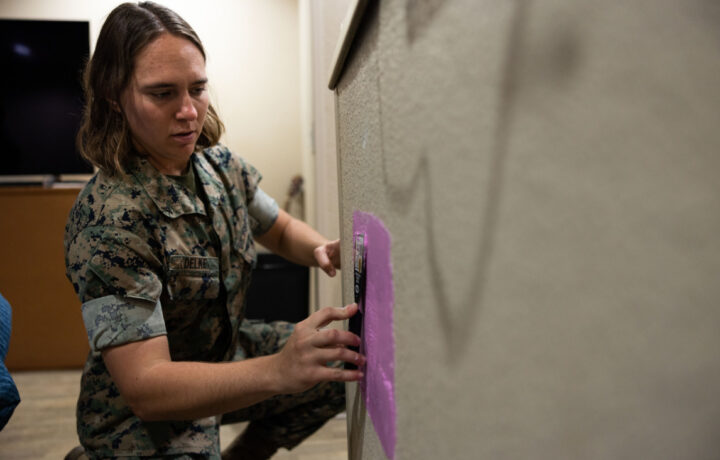If you have spent time in or around the military, I can guarantee that you have heard about the ongoing issues over the conditions of junior enlisted barracks and military housing. Cheap construction, flooding, dirty and unsafe conditions, and the one that caps them all; mold, mold, and more mold.
Why is it that the military, no matter which branch, cannot seem to get past the issue of mold within the barracks? Is it a lack of education, leadership presence in the barracks, materials used, or something else? As someone who lived in several barracks facilities on several military installations, but never dealt with mold in my room, at least the kind that seems to persist like it does today, I wanted to know why this is still so problematic.
What Is The Government Doing?
According to a 2023 report by the Government Accountability Office, the “DOD doesn’t have reliable information about barracks conditions, or how these conditions affect troop morale. And while DOD spends billions of dollars annually on its facilities, it’s unable to identify how much funding goes toward barracks.”
The GAO has issued 31 recommendations for the DoD and military branches to improve barracks conditions, secure complete funding information, and enhance program oversight. The DoD agreed with 23 recommendations and partially agreed with eight, citing ongoing actions for some. The GAO insists that all recommendations should be fully implemented. Some of these measures include simply surveying service members who live in the barracks consistently and comparably, and others include the adjustment of how many service members and rank limitations on who should be living in these facilities.
The mold issue in military barracks has persisted for a range of reasons, including aging infrastructure, lack of sufficient funding for building maintenance, and sometimes inadequate attention to environmental factors in barracks design.
The Military’s Fight Against Moldy Barracks
Here’s a closer look at some of the key challenges.
1. Aging Infrastructure
Many barracks were built decades ago. Many of these older buildings are not equipped with modern climate control or ventilation systems. Aging infrastructure tends to develop leaks, cracks, and other issues over time. This can lead to moisture accumulation — a prime condition for mold growth. Replacing or renovating old facilities requires substantial funding and time, often taking a backseat to other defense priorities.
2. Funding Constraints
Military construction budgets are often allocated to operational needs, equipment upgrades, and mission-critical facilities. This means that barracks maintenance can fall lower on the priority list. Budget limitations can delay repairs or necessary upgrades, allowing mold issues to persist and worsen over time. Even though the DoD has recognized mold as a serious health hazard, the allocation of funds to systematically address the problem across all installations is complex.
3. Climate and Environmental Factors
Military bases are located all over the world, often in regions with high humidity or extreme weather. In such climates, keeping moisture under control can be challenging, particularly in barracks without adequate dehumidifiers or climate control systems. The result is a persistent battle against dampness, which creates an ideal environment for mold.
4. Frequent Use and High Turnover
Barracks are high-occupancy, high-traffic facilities. The turnover of personnel moving in and out, especially in training bases, can exacerbate wear and tear. This usage pattern often means maintenance is deferred until it’s critical, instead of being preventive. High turnover also complicates accountability and tracking of maintenance needs, as many different people occupy the space over time.
5. Shortage of Maintenance Personnel
There are often fewer maintenance personnel available to address building upkeep compared to civilian housing complexes of similar size. Moreover, military personnel assigned to these duties may have other job responsibilities, leaving less time for detailed maintenance. Some installations outsource maintenance, but contractors also face staffing shortages and can be restricted by contract terms and funding.
6. Health Risks and Awareness
Mold can cause respiratory issues, allergies, and other health problems, impacting the readiness and morale of the force. Increasing reports and social media coverage of mold issues have pressured leadership to act, but response times vary. When barracks mold issues are made public, leadership may implement short-term fixes, but the root causes, like building design and funding constraints, remain largely unresolved.
The root cause of these issues, and the responsibility, can be assigned to many places and for many reasons. Whether it is a lack of leadership checking on the barracks, or a lack of funding to update and maintain these facilities, the issue is still problematic, and downright hazardous. Mold causes health issues, prolonged exposure can affect service members for life.
Personal Experience
During my time living in barracks, it was up to the soldiers living there to ensure the sanitization of all parts of that facility. It was up to the junior leadership, some of who lived in the same facility to assist and ensure that the cleaning was done to standard. Have times changed so much that it is no longer a priority for junior service members to be responsible for the cleanliness of their homes? Is it too much to direct them to clean their housing? Is it too imposing to inspect for cleanliness and leadership has their hands tied because of the changing of the times? Clearly, I have a lot of questions. I only hope that the leadership that faces these issues is asking the same questions in order to best take care of those who can be affected by the mold issue for the rest of their lives.
No matter what, the mold issue in military barracks is not simply a maintenance problem but also one deeply rooted in structural, financial, and operational challenges. Addressing it will likely require a large-scale, long-term investment in both infrastructure and personnel resources.




